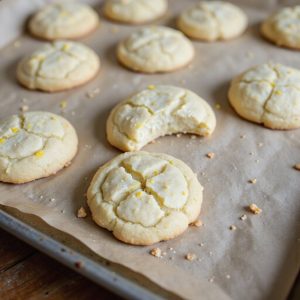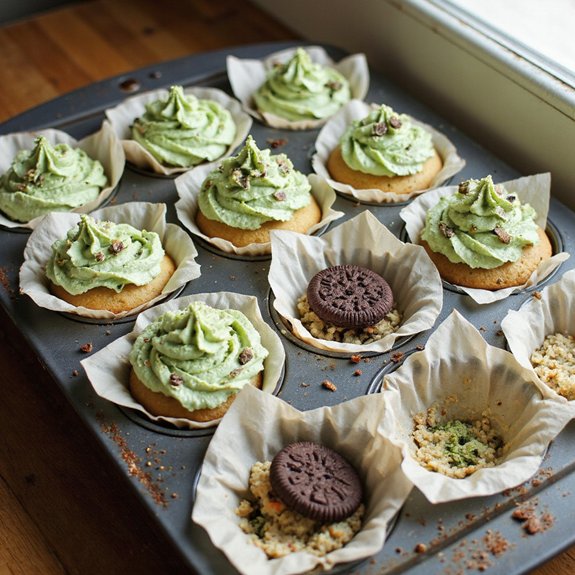Picture a tray of sunlit cookies, edges gently crisp and centers plush as a pillow, sparkling with sugar like frost at dawn.
Imagine breaking one open: steam carries bright lemon perfume, butter warmth, and the soft crackle of poppy seeds—a small, steady comfort on a long day.
These cookies balance tang and sweetness, a citrus hug that feels right for busy weeknights, Sunday suppers, after-school snacks, or a late-night cup of tea when you need something quietly joyful.
I first baked them on a rainy afternoon when our sourdough jar was brimming with discard and everyone needed a pick-me-up; one batch later, the house smelled like a bakery, and the mood lifted as quickly as the cookies cooled.
They’re unfussy, freeze beautifully, and deliver that bakery-chewy center with a lemon glow you can dial up or down.
Ready? Let’s cook!
Why You’ll Love It
- Delivers bright lemon tang with subtle sourdough complexity
- Balances chewy centers and crisp, sugared edges
- Uses pantry staples and unfed sourdough discard
- Mixes quickly; no overnight chill required
- Freezes beautifully for bake-on-demand cookies
Ingredients
- 170 g unsalted butter softened — room temp for easy creaming
- 200 g granulated sugar divided — 180 g for dough, 20 g for rolling
- 1 large egg room temperature — blends more evenly
- 120 g sourdough starter discard unfed — adds subtle tang and moisture
- 1 tablespoon lemon zest finely grated — zest directly over bowl for aroma
- 2 tablespoons lemon juice fresh — adjust by 1–2 tsp for brighter flavor
- 1 teaspoon vanilla extract — pure vanilla preferred
- 260 g all-purpose flour — measure accurately for best texture
- 1/2 teaspoon baking soda — guarantees spread and lift
- 1/2 teaspoon baking powder — aids tenderness
- 1/2 teaspoon fine sea salt — balances sweetness
- 1 tablespoon poppy seeds — for crunch and speckled look
- 40 g coarse sanding sugar optional for rolling — sparkly, lightly crisp coating
Step-by-Step Method
Cream the Butter and Sugar
Preheat oven to 350°F (175°C). Line two baking sheets with parchment.
In a large bowl, beat softened butter with 180 g granulated sugar until light and fluffy, about 2 minutes. Use a hand or stand mixer with paddle. Scrape the bowl as needed to make sure even aeration and a pale, creamy texture.
Whisk the Dry Ingredients
In a separate medium bowl, whisk together the flour, baking soda, baking powder, fine sea salt, and poppy seeds. Break up any lumps.
Distribute leavening and seeds evenly so the cookies bake uniformly. Set this bowl aside. Keep your whisk moving briskly to evenly combine without compacting the flour.
Incorporate Egg and Flavorings
Beat in the egg until fully incorporated and creamy. Add sourdough discard, lemon zest, lemon juice, and vanilla.
Mix until smooth and cohesive. Zest the lemon directly over the bowl to capture aromatic oils. Don’t overmix; stop once the mixture looks silky and uniform with no streaks.
Combine Wet and Dry
Add the dry ingredients to the wet mixture. Switch to a rubber spatula and fold just until no dry streaks remain.
Scrape the sides and bottom to catch hidden flour pockets. Avoid overmixing to prevent tough cookies. The dough should be soft and slightly tacky but hold together well.
Rest to Hydrate
Cover the bowl and let the dough rest for 30 minutes. Allow flour to hydrate and gluten to relax for better texture and spread.
If your discard is very thin, chill an additional 10–15 minutes for easier handling. Use this time to prepare your sugar coating and clear workspace.
Prepare the Sugar Coating
In a small bowl, combine sanding sugar and the remaining 20 g granulated sugar. Stir to mix evenly.
The blend adds sparkle and crunch. If skipping sanding sugar, plan to gently flatten dough balls before baking for more even spread and defined edges. Keep the bowl nearby for rolling.
Portion and Roll
Use a 1.5-tablespoon cookie scoop to portion dough. Roll each portion into a smooth ball between your palms.
Coat lightly in the sugar mixture, turning to cover all sides. Shake off excess. Arrange dough balls on prepared sheets, spacing them 2 inches apart to allow for even spreading.
Bake to Just-Set
Bake one sheet at a time for 10–12 minutes. Look for set edges and centers that are slightly soft and puffy.
For crisper edges, let them go until lightly golden. For chewier centers, pull when pale and just set. Rotate the pan once if your oven bakes unevenly.
Cool and Finish
Cool cookies on the sheet for 5 minutes to set structure. Transfer to a cooling rack to cool completely.
This prevents carryover steam from softening bottoms. Store airtight once fully cool. Freeze dough balls up to 2 months; bake from frozen, adding 1–2 minutes to the bake time.
Ingredient Swaps
- No sourdough discard: use 60 g plain yogurt or kefir + 60 g flour; or 60 g buttermilk + 60 g flour. Flavor will be slightly less tangy.
- Dairy-free: replace butter with equal weight plant butter (stick style) or 150 g refined coconut oil; chill dough 15 extra minutes if soft.
- Gluten-free: use a 1:1 gluten-free all-purpose blend with xanthan; add 1–2 teaspoons extra lemon juice if dough seems dry.
- Egg-free: substitute 1 flax egg (1 tbsp ground flax + 3 tbsp water, rested 5 min) or 3 tbsp aquafaba; bake toward the longer end.
- Lemon: swap zest/juice with orange or grapefruit; or 1–2 teaspoons bottled lemon juice plus 1/2 teaspoon lemon extract if fresh unavailable.
- Poppy seeds: use chia or sesame seeds, or omit.
- Sugar: standard granulated works; for budget-friendly finish skip sanding sugar or use extra granulated sugar for rolling.
You Must Know
- Doneness • If edges look set but centers are domed and pale with slight sugar sparkle, pull them at 10–11 minutes; they’ll collapse to chewy centers as they cool for 5 minutes on-sheet, preventing overbake dryness.
- Troubleshoot • If cookies spread too much into thin puddles, chill the dough 20–30 minutes more or add 10–15 g flour; thin discard ups hydration, and cooler/firm dough keeps a 2.5–3 inch final diameter.
- Flavor Boost • For a brighter lemon pop, rub zest into the 180 g sugar for 30–60 seconds before creaming and add 1–2 teaspoons extra juice; the oils perfume the sugar and the extra acid heightens tang without curdling at room temp.
- Swap • For no sanding sugar, roll in 20 g granulated sugar only and gently press each ball to 1/2 inch thick right before the oven; this encourages even spread and defined crackle without the coarse crunch.
- Scale • For a half batch (12 cookies), use: butter 85 g, sugar 100 g (plus 10 g for rolling), egg 25 g (beat one egg, use ~1/2 by weight), discard 60 g, flour 130 g, leaveners/salt each halved, poppy 1.5 tsp; bake time stays 10–12 minutes, check at 9.
Serving Tips
- Serve with lemon curd or tangy yogurt for a bright, creamy dip.
- Pair alongside hot Earl Grey tea or iced green tea with lemon.
- Plate with fresh berries and a dusting of powdered sugar.
- Sandwich two cookies with vanilla or lemon ice cream; roll edges in poppy seeds.
- Crumble over yogurt parfaits or citrus sorbet for texture.
Storage & Make-Ahead
Store cookies airtight at room temperature 3–4 days or refrigerated up to 1 week.
For make-ahead, chill dough (covered) up to 48 hours to deepen flavor.
Freeze scooped dough balls or baked cookies up to 2 months.
Bake from frozen, adding 1–2 minutes, or thaw baked cookies at room temp.
Reheating
Reheat gently: microwave 1 cookie 8–12 seconds wrapped in a paper towel.
Oven at 300°F for 4–6 minutes on a sheet.
Stovetop skillet low heat 1–2 minutes per side.
Lemon Cookies in Literature
As the warmth returns to a reheated cookie, I think about how lemon sweets have long warmed the page, too—bright little suns tucked into stories where comfort meets memory.
When a character bites a lemon cookie, I hear the soft crackle of sugar and feel a citrus mist lift grief, sharpen hope, or anchor a reunion. Writers use that tart-sweet snap like punctuation—clean, decisive, tender.
I picture a saucer beside a letter, crumbs like confetti of courage. A grandmother presses a still-warm round into a palm; zest oils bloom, and a promise travels farther than words.
Lemon brightens narrative shadows the way it brightens butter—cutting heaviness, revealing detail. When you bake these, you’re joining that chorus: simple, fragrant, and quietly luminous.
Final Thoughts
Ready to bake? Give these bright, tangy cookies a try and tweak the lemon or poppy seeds to suit your taste.
Don’t forget to stash a few dough balls in the freezer for instant cookie cravings!
Frequently Asked Questions
Can I Make These Gluten-Free Without Gritty Texture?
Yes. I swap in a quality 1:1 gluten-free flour with xanthan, whisk in 15 g fine almond flour, and rest the dough 45–60 minutes. You’ll get tender, non-gritty crumbs, delicate edges, and bright lemon pop.
How Do Altitude Adjustments Affect Spread and Bake Time?
At high altitude, cookies spread faster and bake quicker. I’d bump flour 1–2 tablespoons, reduce sugar slightly, add a splash more liquid, and bake hotter (10–15°F). Watch edges: set, pale centers; pull early. Adjust by feel.
What’s the Best Way to Ship These Cookies Safely?
I double-wrap each cookie, stack snugly in a rigid tin, cushion with crumpled parchment, then box-within-a-box. I ship priority, add desiccant, avoid weekends, and mark “fragile.” You’ll hear gentle thuds, not crumbs sighing.
Are There Egg-Free Versions That Still Rise Well?
Yes—I swap the egg for 3 tablespoons aquafaba or 1 tablespoon ground flax + 3 tablespoons water. I boost baking powder to 3/4 teaspoon. You’ll still get tender lift, crisp edges, and plush, lemony chew.
How Can I Naturally Color the Sugar Coating?
Use naturally dyed sugar: I grind freeze-dried raspberries, blueberries, or mango with sugar; or stir matcha, turmeric, beet powder, or butterfly pea tea into sanding sugar. I toss warm cookies lightly so jewel tones cling.

Sourdough Lemon Poppy Sugar Cookies
Equipment
- 2 Mixing bowls
- 1 hand mixer or stand mixer with paddle
- 1 Whisk
- 1 Rubber spatula
- 2 baking sheets
- 2 sheets parchment paper
- 1 microplane zester
- 1 Measuring cups set
- 1 Measuring spoons set
- 1 Small bowl
- 1 Cookie scoop 1.5 tablespoons
- 1 Cooling rack
Ingredients
- 170 gram unsalted butter softened
- 200 gram granulated sugar divided
- 1 large egg room temperature
- 120 gram sourdough starter discard unfed
- 1 tablespoon lemon zest finely grated
- 2 tablespoon lemon juice fresh
- 1 teaspoon vanilla extract
- 260 gram all-purpose flour
- 1/2 teaspoon baking soda
- 1/2 teaspoon baking powder
- 1/2 teaspoon fine sea salt
- 1 tablespoon poppy seeds
- 40 gram coarse sanding sugar optional, for rolling
Instructions
- Preheat the oven to 350°F (175°C) and line two baking sheets with parchment paper.
- In a medium bowl whisk together flour, baking soda, baking powder, salt, and poppy seeds.
- In a large bowl beat the softened butter with 180 g granulated sugar until light and fluffy, about 2 minutes.
- Beat in the egg until fully incorporated and creamy.
- Mix in the sourdough discard, lemon zest, lemon juice, and vanilla until smooth.
- Add the dry ingredients to the wet and stir with a spatula just until no dry streaks remain.
- Cover the bowl and let the dough rest for 30 minutes to hydrate and relax.
- Place sanding sugar and the remaining 20 g granulated sugar in a small bowl and stir to combine.
- Scoop 1.5-tablespoon portions of dough, roll into balls, and coat lightly in the sugar mixture.
- Arrange dough balls 2 inches apart on the prepared baking sheets.
- Bake one sheet at a time for 10–12 minutes until edges are set and centers look slightly soft and puffy.
- Cool on the sheet for 5 minutes, then transfer cookies to a rack to cool completely.





